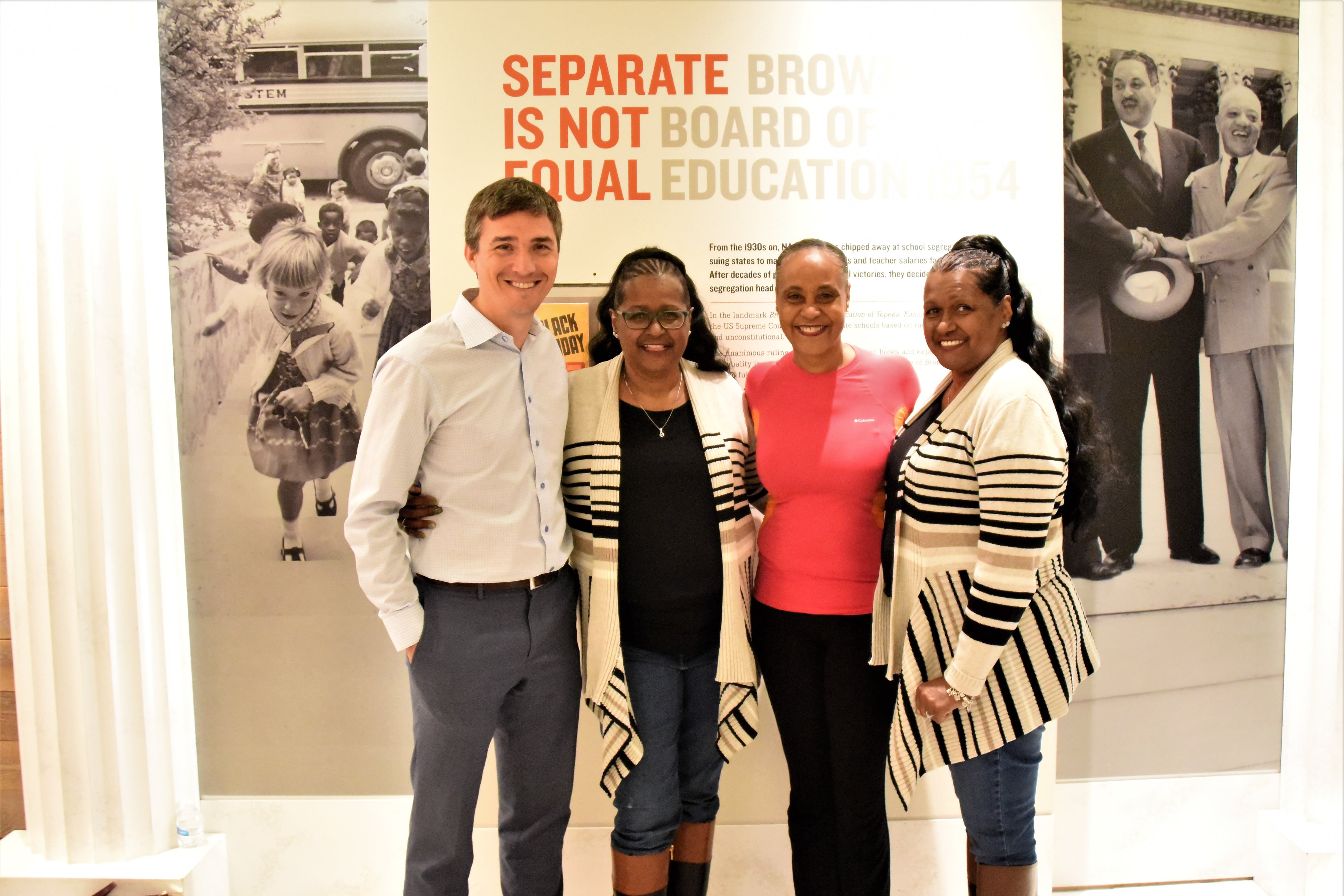Sign up for Chalkbeat Tennessee’s free daily newsletter to keep up with statewide education policy and Memphis-Shelby County Schools.
When Daniel Kiel was a student at Grahamwood Elementary and White Station High School in the 1980s and 1990s, he knew he was getting a good education.
What he didn’t know was whether most of the Black students in his school were receiving the same.
“I was in the optional program at those schools, but it was a school within a school, which meant there was a traditional program alongside it,” said Kiel, now a constitutional law professor at the University of Memphis.
“While Grahamwood and White Station were extraordinarily diverse compared to many Memphis schools at the time, my classrooms were not. My classrooms were 80% to 90% white students, which meant that the other classes were 80% to 90% Black students.”
That experience, plus many others, set Kiel on a mission to explore why his classrooms looked the way they did, the history behind it all, and a system that continues to grapple with how to provide a quality education for all students.
The mission took him to Harvard Law School and to private law practice in Boston before he received a Fulbright scholarship and became a professor at the Cecil C. Humphreys School of Law at the University of Memphis. His scholarly work centers on race and education — work that led him to produce a documentary in 2011 titled “The Memphis 13,” chronicling the stories of the first Black students to attend all-white public elementary schools in Memphis in 1961.
That was seven years after the Supreme Court decision in Brown v. Board of Education of Topeka, Kansas, that declared that mandated school segregation was unconstitutional.
This month marks the 70th anniversary of that decision. In recognition of that milestone, Chalkbeat spoke with Kiel about how the ruling influenced his interest in educational equity, the current state of school desegregation, and how new laws and interpretations of racial justice are poised to undermine it.
This interview has been lightly edited for length and clarity.
How did the Brown decision influence your life and decision to pursue constitutional law?
By the time I was graduating college and entering law school, I was a huge admirer of Thurgood Marshall and the NAACP Defense Fund, and the idea of lawyers forcing the country to grapple with injustice. So it was that idea that took me to law school.
When I was in law school, it was actually around the 50th anniversary of Brown v. Board of Education, so there was some interesting coursework that I was allowed to take. We had studied Little Rock, Charlotte and Detroit … . I knew there was a connection to Memphis, and I knew from my experiences there wasn’t education justice in Memphis.
It was at that point that I started digging into the Memphis schools as part of a curiosity project as to why my schools looked like they did.
Describe what happened in the seven years between 1954, when Brown outlawed legal segregation, and 1961, when the first Black children were enrolled in Memphis’ all-white elementary schools.
For the first few years, and not just in Tennessee, there’s this thought (in Southern states) that they won’t have to abide by the ruling. Then the (Tennessee) legislature took race out of school assignments, with freedom of choice (a plan in which schools still had the discretion to deny Black student requests to enroll in all-white schools), but that still allowed local schools to maintain segregation.
That spurred the 1960 Memphis lawsuit Northcross v. Memphis City Schools, and led to the first Black students being allowed to attend white elementary schools in 1961. After the courts ordered desegregation efforts to be stepped up in the late 1960s, the process accelerated.
Still, in the 1970s, most students were still operating in segregated environments.
How do your students react to lessons about school segregation and how it was the law of the land before Brown?
They’re surprised. My students come with a range of familiarity with that story, so there’s definitely students who know that story well and aren’t surprised by it, and know how things unfolded afterward, but there also are those students who think that when the Supreme Court ruled, that was that, and all of a sudden segregation went away.
For some of my students, a lot of unlearning has to happen before they’re learning. In a particular course I teach, Education and Civil Rights, we use the Brown story and narrative as a case study to set up other kinds of pushes toward educational justice that have occurred in the United States, whether they are based on poverty, immigration status, or disability, or sex. It’s a touchstone case that the students enjoy grappling with methodically.
Recently, the Tennessee legislature tried to pass a voucher law permitting anyone, regardless of income, to use public money to pay for private school for their children. What are your thoughts on whether this universal voucher bill — which Gov. Bill Lee has vowed to reintroduce next year — will worsen school segregation?
Vouchers are hard to talk about, because the theory behind them is an attractive one, which is to give every student a chance at opportunity regardless of their circumstances. But there’s a risk involved in disabling the schools that are more likely to serve large numbers of disadvantaged students — especially in Shelby County, and in the state more broadly.
But I think about history and the way things pop up repeatedly in different guises, and in the 1950s, one of the first responses to Brown in Virginia, and one of the ways they resisted the court order, was for the school system to shut down and not have public education anymore. While that seemed awful and shortsighted, what made it worse was that they provided vouchers to students who wanted to attend private schools. But of course, the private schools were openly discriminatory and exclusive, so what vouchers were, in that instance, (was) a mechanism to maintain segregation.
Vouchers, in their 21st century form, aren’t those things precisely, but they are consistent with the idea that it’s not us, the people, the community, that is responsible for education, but that education is an individualized thing. You create an unequal playing field when you give an individual control of those things, because the way that those laws get passed, and the way vouchers typically show up, is that not every school has to take them. Students and families are often responsible for their own transportation, so that’s an access issue, and then the things that happen inside schools once they’re there can be hateful and hurtful and stigmatizing, and there’s no support for that within a voucher program.
I think the theory behind vouchers is an attractive one. It sort of draws me to the work of pushing for education equity more broadly, but in practice it has never served that goal.
What other developments do you believe can undermine the promise of Brown?
It’s not hard to look at the landscape of the way we do education and find disparities that look like the disparities from 70 years ago. They’re not the same in that the law doesn’t specifically mandate them, but it’s easy to find those disparities, and they’re discouraging.
In my space, I look at the way the U.S. Supreme Court has, in particular, transformed the Brown decision not into a decision about remedying historical injustices, but into a decision about colorblindness and government race-neutrality. I feel like neutrality didn’t get it done in 1955, and I don’t think neutrality is likely to get it done today.
The law is moving in a direction where it’s a little harder to see where you can push for the kinds of educational investments that are needed to produce equal education opportunities today. That’s one thing. But I think part of the reason why the disparities still exist is a broader lack of will from all of us that something should be done.
It’s easy to say equal opportunity should exist, but it’s harder to turn that into action and policy and results. It’s not impossible, but one thing I think is important is to lift up teachers and families and community groups and advocates who are pushing for this every day, and who are succeeding.
So, how should we view the Brown decision through today’s lens?
The story that most people want to tell about Brown is one of missed opportunities, and I think there’s something to that. But there’s been a huge increase in educational attainment in our society since 1954.
If we’re looking at high school graduation and college attendance and employment figures, achievements that were unthinkable in Black communities are now the norm. There has been a lot of progress.
I try not to lose sight of the fact that a lot has changed since 1954, and that a lot of people are still working on that.
Bureau Chief Tonyaa Weathersbee oversees Chalkbeat Tennessee’s education coverage. Reach her at tweathersbee@chalkbeat.org.






